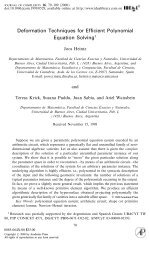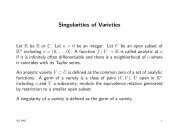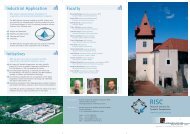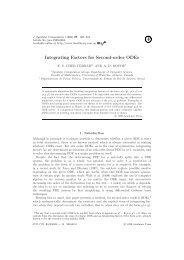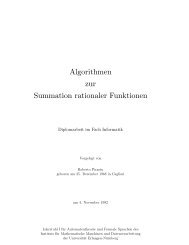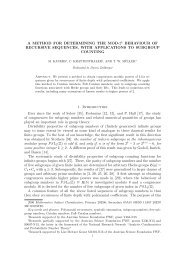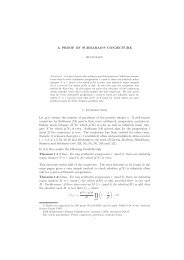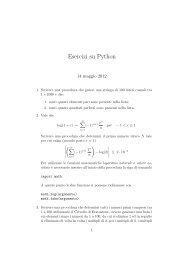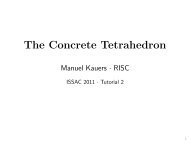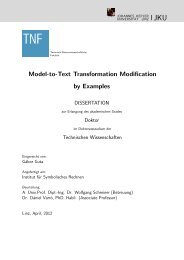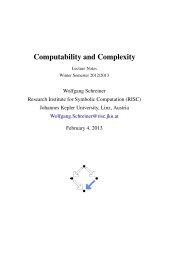Automated Formal Static Analysis and Retrieval of Source Code - JKU
Automated Formal Static Analysis and Retrieval of Source Code - JKU
Automated Formal Static Analysis and Retrieval of Source Code - JKU
Create successful ePaper yourself
Turn your PDF publications into a flip-book with our unique Google optimized e-Paper software.
3<br />
Contributions <strong>of</strong> the Thesis<br />
The statical approach for checking the program correctness is based on forward symbolic execution<br />
<strong>and</strong> functional semantics, but, additionally, gives formal definitions in a meta-theory for the<br />
meta-level functions (describing the semantics, the partial correctness <strong>and</strong> the termination condition<br />
<strong>of</strong> the programs) <strong>and</strong> predicate (defining the syntax <strong>of</strong> the programs) which characterize the<br />
object computation.<br />
While most <strong>of</strong> the work which treats the problem <strong>of</strong> forward symbolic execution <strong>and</strong> functional<br />
semantics describes textually these principles ([BEL75]), we formalize them in predicate<br />
logic because the formalization gives the possibility <strong>of</strong> reflective view <strong>of</strong> the system by describing<br />
how the data (the state, the program, the verification conditions) are manipulated <strong>and</strong> by introducing<br />
a causal connection between the data <strong>and</strong> the status <strong>of</strong> computation (a certain statement<br />
<strong>of</strong> the program determines a certain computation <strong>of</strong> the function describing the semantics, <strong>of</strong> the<br />
functions generating the verification conditions <strong>and</strong> <strong>of</strong> the termination condition to be performed).<br />
We mention that our approach keeps the verification process very simple: the verification<br />
conditions insuring the partial correctness are first order logic formulae, the termination principle<br />
is expressed as an induction principle in the underlying logic <strong>of</strong> the programs, without introducing<br />
any model <strong>of</strong> computation like, for example, the Scott fix-point theory ([LSS84]).<br />
Approaches for solving the correctness <strong>of</strong> symbolic executed programs exists due to [LSS84,<br />
Top75, Deu73]; for the imperative programs containing assignments, conditionals <strong>and</strong> while<br />
loops bounded on the number <strong>of</strong> times they are executed, the pro<strong>of</strong> <strong>of</strong> correctness is given by<br />
analyzing the verification conditions on each branch <strong>of</strong> the program. For the programs containing<br />
loops with unbounded number <strong>of</strong> iterations, the branches <strong>of</strong> the program are infinite <strong>and</strong> have to<br />
be traversed inductively in order to prove/disprove their correctness. In the inductive traversal <strong>of</strong><br />
the tree, additional assertions have to be provided, called inductive assertions. But the inductive<br />
assertions method applies to partial correctness pro<strong>of</strong>s ([LSS84]), while our approach concentrates<br />
in proving the total correctness <strong>of</strong> programs.<br />
For code search engines there is a lot <strong>of</strong> expertise both theoretical <strong>and</strong> practical ([GAL + 06]),<br />
where the main issues are emphasized as being the accuracy <strong>and</strong> the reuse <strong>of</strong> the results. Some<br />
results were already achieved in the prototypes like Maracatu (as part <strong>of</strong> RiSE – Reuse in S<strong>of</strong>tware<br />
Engineering), but the main objective is to provide a framework for helping organizations in all<br />
aspects <strong>of</strong> implementing a reuse program.<br />
Regarding this problem, our task was to integrate in an information retrieval system (Mindbreeze<br />
Enterprise Search (MES)) the facility <strong>of</strong> source code retrieval. This was relatively easy<br />
achievable due to the loosely-coupled architecture <strong>of</strong> the MES system.<br />
Our tasks consisted in: (i) the construction <strong>of</strong> a custom crawler, specialized for source code<br />
files crawling, (ii) the integration <strong>of</strong> a new data source, representing source code files category,<br />
<strong>and</strong> (iii) the enhancing <strong>of</strong> Query Service Context Interface such that it provides context items<br />
(context icons, context menus, context actions) specific to the new category integrated.<br />
One <strong>of</strong> the components <strong>of</strong> the custom crawler is a tagger which crawls the relevant information<br />
(hit – types <strong>and</strong> their metadata) from the source code files repositories. The tagger is applied<br />
first because it structures the information fast <strong>and</strong> has support for many programming languages.<br />
Its disadvantage (the metadata retrieved have not very powerful semantic meaning) required the<br />
integration <strong>of</strong> another component, namely a parser. But the information obtained from tagging



